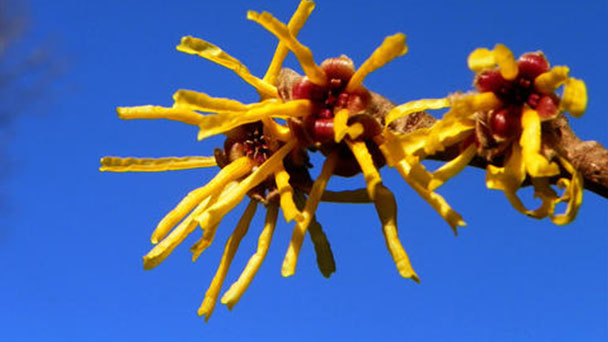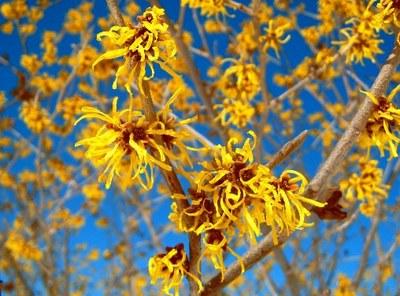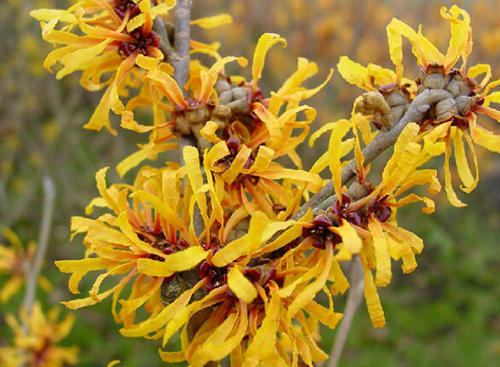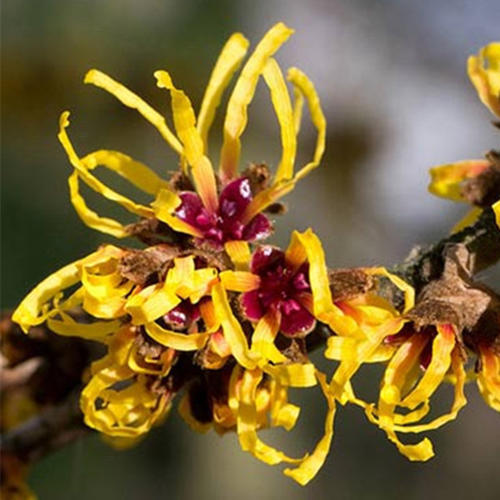Chinese witch hazel (Hamamelis mollis) profile
Written by Maggie
Nov 05 2021

Chinese Witch Hazel, scientific name Hamamelis mollis, is a deciduous shrub or small tree with a height of 8 meters, belonging to the order Rosa, family Chinese Witch Hazel. Shoots are with stellate tomentose; Old branches are bare and clean.
Chinese witch hazel picture

Chinese witch hazel info
| Botanical Name | Hamamelis mollis |
| Common Names | Chinese witch hazel |
| Plant Type | Deciduous shrub |
| Sun | Full sun to part shade |
| Hardiness Zones | 5 to 8 |
| Flower color | yellow with reddish-brown calyx cups |
| Native Area | Western and west-central China |
| Mature size | 10.00 to 15.00 feet high, 10.00 to 15.00 feet wide |
Morphological characteristics of Chinese witch hazel
Chinese witch hazel is a deciduous shrub or small tree, up to 8 m high; Shoots are with stellate tomentose; Old branches are bare and clean; The sprouts are long and ovate, with grayish-yellow hairs. Leaves of chinese witch hazel are papery or thinly leathery, broadly obovate, 8-15 cm long and 6-10 cm wide, apex short and acute, base unevenly coordinate, upper slightly coarse, with sparse stellate hairs, not shiny, and densely gray stellate hairs below; Lateral veins are 6-8 pairs, the lowest pair of lateral veins having a distinct second lateral vein, prominent above and protruding below; Margin undulates obtuse teeth; Petiole is 6-10 mm long, tomentose, stipules caducous.
Inflorescences head or spicate of Chinese witch hazel are axillary, several flowered, sessile, bracts ovate, petiole short, less than 5 mm long; Calyx tube is short, connate with the ovary, calyx teeth ovate, 3 mm long, persistent, stellate tomentose; Petals are banding, ca. 1.5 cm long, yellow-white; Chinese witch hazel has 4 stamens, filaments 2 mm long, anthers and filaments almost equal; Stamens apex is truncated; Ovary is tomentose, style 1-1.5 mm long.
The capsule of Chinese witch hazel is ovoid, 1.2 cm long and 1 cm wide, densely covered with yellowish-brown starlike villi, calyx tube about 1/3 of the length of the capsule. Seeds are elliptic, ca. 8 mm long, black, shiny.
Branchlets of Chinese witch hazel are densely stellate tomentose; The bare bud has a stalk. Leaves are obovate, 8-15cm long, apex acute, base askew cordate, margin undulate teeth, surface slightly rough, abaxially densely villous, lateral veins 7 -- 9 pairs; Petiole is 6 -- 10 mm long. Spices are short, axillary several golden flowers, bisexual flowers, 4 petals, narrow like bands, 1.5 -- 2cm long, pale yellow, reddish base, aromatic; Calyx dorsal with rusty tomentose, stamens 4, filaments 2 mm long, stamens 4, alternate with stamens, apical truncate; Ovary is subepistalate, 2-locules, each locule with L pendent ovules, style 2, very short. The capsule is ovoid, bifid, ca. 1.2cm long.
Ecological Habits of Chinese witch hazel
Chinese witch hazel is mostly born on hillsides, valleys, broad-leaved forest margins and shrubs. Alpine tree species, vertical distribution often in the elevation of 600~1600 meters. Chinese Witch Hazel is a warm-ground tree. Chinese witch hazel has strong cold resistance and can grow in the open field at -15℃. They are fond of light but are more tolerant to shade in early childhood. It can grow in half-shade conditions. The soil requirements are not strict, in the acid, neutral soil can grow. Especially with fertile, moist, loose, and good drainage sandy soil growth.
How to grow and care for Chinese witch hazel
1. Environment
Chinese Witch Hazel likes warm conditions, but they are also cold resistant. The suitable growth temperature of Chinese Witch Hazel is maintained between 15℃ and 35℃, so the curing environment temperature is controlled within this range.
2. Soil
The soil for potted Chinese Witch Hazel is fertile, loose and sandy loam with good drainage. Of course, Chinese Witch Hazel can also grow well in acidic and neutral soil.
3. Lighting
Chinese Witch Hazel likes adequate illumination. In the daily maintenance process, it is necessary to give sufficient illumination. If insufficient illumination and poor growth occur, the flowering effect of Chinese Witch Hazel will be affected.
However, in summer, shading treatment should be carried out for Chinese Witch Hazel to avoid sunburn by strong light in summer.
4. Watering
Chinese Witch Hazel needs to be watered enough to keep the soil moist during the growth period, but there should be no water. Once there is water for a long time, the root system of Chinese Witch Hazel is likely to be damaged.
5. Fertilization
Fertilizer for Chinese Witch Hazel is usually applied once in early spring to promote the growth of Chinese Witch Hazel. In addition, phosphate fertilizer should be applied once before Chinese Witch Hazel blossoms to supplement the nutrients needed by Chinese Witch Hazel during flowering.

Chinese witch hazel propagation
Chinese Witch Hazel is commonly used for sowing and cutting propagation. Sow, collect seeds in autumn, store them indoors, sow seeds in the next spring, and germinate in about 20 days. Cutting, with the best plum rain season, the use of mature branches 10 cm long, inserted into the sand bowl, shading water, inserted after 30~40 days to root.
Disease & pest control of Chinese witch hazel
Disease
Chinese Witch Hazel has leaf spot disease and anthrax can be sprayed with 65% Dixon Zinc WP 600 times liquid. In addition, it can be sprayed with 10% Dichlorothrin Emulsion 2000 times liquid to kill the moth and leaf rolling moth.
Diseases are leaf spot disease and anthrax, which can be used 65% of the Zinc WP 600 times the spray liquid. In addition, it can be sprayed with 10% Dichlorothrin Emulsion 2000 times liquid to kill the moth and leaf rolling moth. Often have large demoiselle moth, moth, adult to light trap kill, larval period to trichlorfon liquid spray kill.
Insect pests
Chinese Witch Hazel is often caused by large demoiselle moths and acanthosis moths. Adults are killed by light traps and larvae are sprayed with trichlorfon liquid.
Distribution of Chinese witch hazel
Chinese Witch Hazel is distributed in Sichuan, Hubei, Anhui, Zhejiang, Jiangxi, Hunan and Guangxi provinces and regions.
Variety classification of Chinese witch hazel
North American Chinese Witch Hazel, also known as Virginia Chinese Witch Hazel, is a deciduous shrub of the genus Chinese Witch Hazel in the family Chinese Witch Hazel. Native to eastern North America, from Nova Scotia, Canada westward to Minnesota and south to central Florida and eastern Texas.
Chinese Witch Hazel is a large deciduous shrub. The stem grows from the base of the plant and the branches are densely grown. The plant can grow up to six meters high, with a few individuals sometimes growing to about ten meters. The bark is light brown, the surface is smooth, the bark is a scaly crack when exfoliate is scaly, the endothelium is red-purple. New branches at the beginning of the birth of pubescent, then become smooth hairless, at this time the branch surface is pale orange-brown, and branches above the scattered with some white dots, the last branches into dark brown or reddish-brown. Leaf buds acute, slightly curved sickle-shaped apex, the surface of a fine hair, leaf buds light brown.
Leaves broadly elliptic, 3.7-16.7 cm long, 2.5-13 cm wide, oblique at the base, asymmetrical on both sides of the base, acute or rounded at the tip, undulate dentate at the margin or shallowly lobed, short and stout petiole, 0.6-1.5 cm long, thick and hairy main veins from the main veins, lateral veins of six to seven pairs. Young leaves are enveloping and curling in the bud, mature leaves are dark green on the surface and lighter on the back, turning yellow in autumn with reddish-brown spots.
Stipules lanceolate, acute, falling off soon after the leaf has unfolded. The flowers are pale yellow to bright yellow, sparse orange or red, with four ribbon-shaped petals, 1 -- 2 cm long, with four short stamens. The flowering period lasts from mid-autumn to late autumn. Calyx deeply lobed, in four segments, hairy outside, orange-brown inside, calyx persistent, bearing at the base of the ovary.
The fruit is a woody capsule, 1-1.4 cm long, which ripeness a year after pollination. When ripe, the fruit bursts open from the top and shoots two bright black seeds that can bounce more than 10 meters from the parent tree. North American Chinese Witch Hazel is similar to its relative species, Chinese Witch Hazel (Hamamelis vernalis), which can be distinguished by the flowering period. The flowering period of North American Chinese Witch Hazel is from Mid-Autumn to late autumn, while the flowering period of spring Chinese Witch Hazel is from mid-winter to early spring. (Find more fall plants here.)
Chinese witch hazel distribution
Chinese Witch Hazel is a native species in East China and a national first-class protected tree species. The ancient plant is contemporary with dinosaurs, deciduous trees, up to 8m tall, diameter at breast height up to 40cm. The trunk is twisted and uneven, and the bark is peeling off in irregular sheets. Chinese witch hazel is produced in Zhejiang, Jiangsu and Anhui provinces.
Chinese witch hazel uses
Ornament value
Simple tree posture, dry form vigorous, leaves turn yellow in autumn, Chinese witch hazel can be used as landscape trees, is also an excellent bonsai tree species.
Economic value
Hard material, straight texture, fine structure, smooth cut, light brown, shiny, Chinese witch hazel can be used for joinery, handicrafts, furniture, etc.
Scientific research value
East China special species, national first-class protected tree species. The ancient plants contemporary with dinosaurs are of great value for the study of the East Asian and North American flora and the phylogeny of the Chinese Witch Hazel family.
Garden use of Chinese witch hazel
The flowers of Chinese Witch Hazel are peculiar and fragrant. The leaves of the grass open before spring. The yellow slender petals are like a wisp of gold. Garden often cultivated at home and abroad, and some good varieties appear, is one of the famous ornamental flowers. In the corner of the courtyard, the pool, streamside, between the rocks and trees are very suitable. In addition, flower branches can be cut vase insert material. If you want to urge flowers, the branches will be cut off the bottle between December and January of the next year in a greenhouse at about 20℃, about 10-20 days can be flowering.

Read Next:
Top 30 Fall Flowers to Plant - Beautiful Autumn Flowers
30 Fall Plants for a Beautiful Fall Garden
Latest Updated
- Benefits of Bugleweed - 7 Science-backed Health Benefits
- Bugleweed Dangers & Side Effects - Is It Poisonous?
- How to Plant Evergreen Trees - What You Should Know
- When to Plant Evergreens - Grow Guide for Evergreen Trees
- 12 Wonderful Evergreen Shrubs for Your Garden
- 12 Popular Evergreen Plants with Pictures for Beginners
- When And How To Prune A Lilac Bush Like a Pro
- How to Grow & Care for Lilac Vine (Hardenbergia Violacea)
- Japanese Lilac Tree (Syringa Reticulata) Care & Propagation Guide
- Shumard Oak Pros and Cons - What to Know
Popular Articles
- Winter maintenance of Antirrhinum Majus
- How to Grow Terminalia Mantaly Tree
- How to Grow and Care for Crossostephium Chinense
- How to grow Antirrhinum Majus in spring
- Peristeria Elata (Dove Orchid) Profile: Info & Care Guide
- Underwatered Snake Plant (Sansevieria Trifasciata) - Signs And How To Fix
- How to Care for Brazilian Jasmine Plant (Mandevilla Sanderi)
- How to Grow & Care for Graptopetalum Purple Delight in Summer
- Rosa Chinensis (China Rose): Plant Growing & Care Tips
- How to Care for Baby Sun Rose (Aptenia Cordifolia)